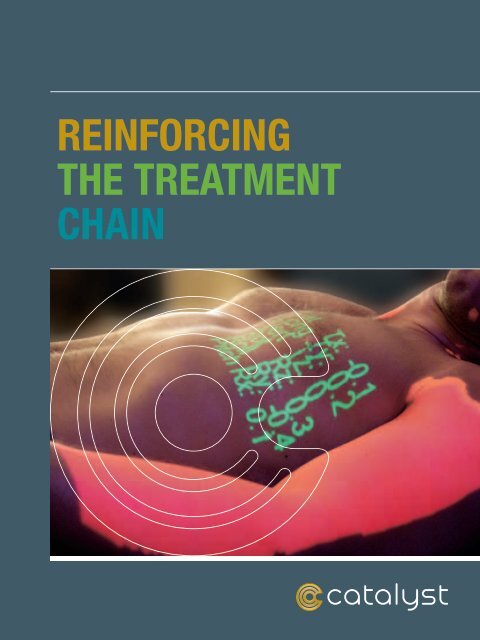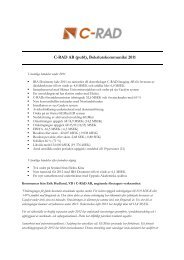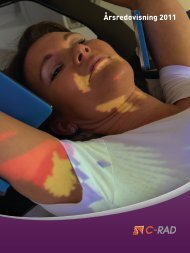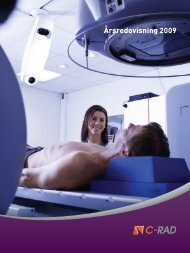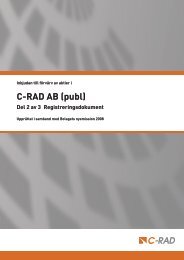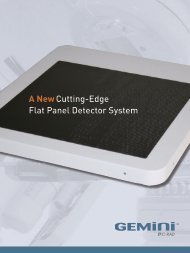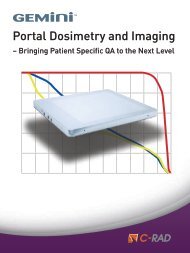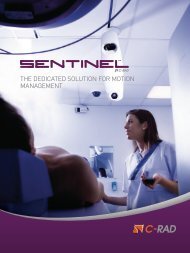Catalyst Brochure - C-RAD
Catalyst Brochure - C-RAD
Catalyst Brochure - C-RAD
Create successful ePaper yourself
Turn your PDF publications into a flip-book with our unique Google optimized e-Paper software.
REINFORCINGTHE TREATMENTCHAIN
REINFORCINGTHE TREATMENTCHAINRadiation therapy has evolved considerably during thepast few decades, with the introduction of increasinglyconformal treatment techniques as well as capabilitiesfor on-board volumetric imaging in the treatmentrooms. This has enabled a new level of accuracy inthe delivered dose distributions with a correspondingimprovement in clinical outcomes.Looking at the treatment chain as a whole there ishowever still room for improvement. While many linksare now strong, others remain weak. Only when all thelinks have been strengthened, the complete chain willbe stronger.It’s time to continue the work of reinforcing the treatmentchain.VOLUMETRICIMAGINGImage quality issuesdue to respiratorymotionInformation loss inmultimodal imagingTREATMENTPLANNINGLack of dynamicinformation
IntuitiveRequiring minimal user interaction, the <strong>Catalyst</strong> actsas an always present decision support system where therequired information is projected directly on the couchor patient. The system’s high performance provides immediateand real-time feedback, which means that thetherapist can keep focusing on ensuring the best possiblepatient comfort and treatment outcome.ConnectedThe <strong>Catalyst</strong> software is built from the ground up fora networked environment. Tight integration with othersystems in the clinic ensures a smooth work-flow wheredata is transferred automatically via industry standardor vendor specific interfaces. When the patient is selectedin the R&V system, the same patient is automaticallyselected in the <strong>Catalyst</strong>, and computed shifts can in most cases also be applied automatically.The central patient database ensures that the correct settings are always availableeven in cases where the patient needs to be treated in a different room.INTRA-FRACTIONMOTION DETECTIONThe patient is continuously monitoredduring the entire fraction. Any deviationsoutside the set tolerances willbe signaled by an audible and visualalarm, or alternatively a beam holdsignal can be triggered.4DCT reconstruction as well as prospectivelygated imaging. The patient´s respiratory characteristicsare also recorded, which makes itpossible to verify that the same breathing patternis reproduced in the treatment room.In cases where multi-modality imaging is employedto obtain a more complete picture, havinga <strong>Catalyst</strong> in each room provides a commonreference frame for performing image fusionusing the captured data sets.Treatment PlanningEven with today’s advanced treatment techniques,treatment planning is still typically doneonly once, before the first treatment fraction.Anatomical changes and other dynamic informationcannot therefore be taken into account,which limits the accuracy of treatment delivery.By incorporating information on the actual patientmovement during the fractions alreadydelivered, the treatment plan for the remainingfractions can be adapted to compensate forany deviations, such as patient relaxation afterinitial positioning. Stochastic deviations can beanalyzed for determining whether the patient isproperly immobilized and whether the set PTVmargin is appropriate.Setup of Immobilization DevicesImmobilization devices play an important rolein achieving a reproducible patient setup. It istherefore very important that the correct devicesbe placed at the correct index positions onthe couch, and that any adjustments be doneproperly for each patient. This critical informationon the exact placement and configurationof devices is however often documented only astextual setup instructions in the patient journal,with no independent means of verification.With the <strong>Catalyst</strong>, the patient specific setup isrecorded once at the first treatment fraction oreven at the time of the planning CT. In the treatmentroom, the setup instructions are projecteddirectly onto the treatment couch. Placement ofeach immobilization device is verified as are anyadjustments required.Patient IdentificationWith the steadily increasing demands on timeefficiency in combination with more flexible treatmentscheduling options, making sure thateach patient receives treatment according tothe correct prescription is more challengingthan ever. The obvious solution is to introducesafety procedures where the patient identity ischecked manually by the therapy staff at eachtreatment fraction.With a <strong>Catalyst</strong>, patient identity is instead verifiedas an integral part of the setup procedure,ensuring patient safety with minimal overhead.Any identity mismatch will be clearly indicatedby an alarm.CONTINOUS RECORDING OFPATIENT POSITION AND POSTUREIn adaptive therapy, a CBCT system istypically used to capture anatomicalchanges at each treatment fraction.Here, the <strong>Catalyst</strong> will recordpatient motion during the actual treatmentdelivery to complete the picture.RESPIRATORY GATINGThe <strong>Catalyst</strong> enables 4DCT orgated imaging during planning CTacquisition. In the treatment room,the patient’s respiratory motion ismonitored to ensure the same breathingpattern as the one recordedin the CT is present. Finally, gatedtreatments are supported where theactual beam delivery is constrainedto a specific respiratory phase orbreath-hold state.^^^Works in progress. Not for sale in the US.
HEALTH MONITORINGIn cases where a patient’s healthneeds to be monitored duringdiagnostic imaging or treatmentdelivery, the <strong>Catalyst</strong> will providea continuous indication of thedetected vital signs.Patient setup and positioning.While IGRT systems are often used for finalpositioning, body tattoos and room lasers aretypically still used for initial setup, meaning thatonly three points on the skin surface are used asthe basis for setting up the whole patient. Correctinga setup error means that the patient positionmust be shifted manually, and then bothsides of the patient checked again for laser/tattooalignment. Also, it is typically not possible todetect posture errors or misalignment of patientextremities with a classic ”3 point set up”.With the <strong>Catalyst</strong>, a complete body surfaceis captured continuously and compared to thepreviously recorded reference setup imagein real time. Any deviations in posture are immediatelyindicated by a projection directlyonto the patient’s skin, ensuring a fully interactivework flow. The required couch shift is alsoshown, providing instructions for moving thepatient to the treatment position, even if setupis done at a lower couch height.The <strong>Catalyst</strong> continuously monitors the patientduring the entire fraction. Any movementsoutside of clinician set tolerances will trigger analarm and optionally pause the beam until thepatient is again within tolerance.Gantry, couch, and patient are also monitoredcontinuously for possible collision risks.Additionally, the patient’s vital signs can alsobe monitored to make sure that the patient is atgood health during treatment delivery.COLLISION AVOIDANCEThrough continuous monitoring ofthe couch, gantry, and patient, the<strong>Catalyst</strong> detects when there is arisk of collision and will then issuean audible alarm.Treatment DeliveryDuring treatment delivery, it is important to continuouslymonitor the patient to make sure thatno clinically significant movements occur. This istraditionally done using in-room video camerasconnected to TV monitors in the control area.While large patient movements can thereby oftenbe detected, this requires the full attentionof the therapists.IMAGE FUSIONIn order to get the most informationfrom diagnostic imaging, thereis sometimes a need to combinethe acquired images from multiplemodalities. The <strong>Catalyst</strong> can, byrecording the patient’s position ateach imaging session, provide a commoncoordinate system to which thedata sets can be co-registered.
SP-002-110429-001-01C-<strong>RAD</strong> ABBredgränd 18SE-753 20 UppsalaSwedenwww.c-rad.se


